
The Ecstasy of Surrender- 12 Surprising Ways Letting Go Can Empower Your Life - by Dr Judith Orloff. Reviewed by Joe Sinclair
Studying Leadership - Traditional & Critical Approaches - by Doris Schedlitzki & Gareth Edwards. Reviewed by Terry Goodwin.
Imprisoned in English - The Hazards of English as a Default Language - by Anna Wierzbicka. Reviewed by Joe Sinclair
Constitutional Referendums - The Theory and Practice of Republican Deliberation - by Stephen Tierney. Reviewed by Sep Meyer
The Oxford Handbook of Happiness - edited by Susan A. David, Ilona Boniwell and Amanda Conley Ayers. Reviewed by Joe Sinclair
The Oxford Handbook of Attention - edited by Anna C. Nobre and Sabine Kastner. Reviewed by Joe Sinclair
MI29 - Mouseweb International to the Rescue!. By S.J. Tozer, Illustrated by Rosy Salaman. Reviewed by Kate Norton
50 Great Myths About Religions - by John Morreall & Tamara Sonn. Reviewed by Sep Meyer
Introduction to the Psychology of Ageing for Non-Specialists - by Ian Stuart-Hamilton. Reviewed by Joe Sinclair
Sleep Better With Natural Therapies - by Peter Smith. Reviewed by Joe Sinclair
Starving the Stress Gremlin - by Kate Collins-Donnelly. Reviewed by Mark Edwards
Coaching and Mentoring for Business - by Grace McCarthy. Reviewed by Julie Hay
Coaching and Mentoring - Theory and Practice, 2nd Edition - by Bob Garvey, Paul Stokes & David Megginson. Reviewed by Julie Hay
BRIEF REVIEWS
Happy Mind Happy Life - How to get happy and stay that way the rest of your life - by Don Schenk. Reviewed by Stephen Bray.
Stephen Bray was one of the original Editorial Board members of Nurturing Potential. He lives in Turkey and is author of Photography and Psychoanalysis and Photography and Zen, amongst others. His website is www.stephenbray.me.
Warriors and Worriers The Survival of the Sexes - by Joyce F. Benenson with Henry Markovits. Reviewed by Penelope Waite.
Penelope Waite retired from full-time teaching many years ago. She was a regular contributor to Nurturing Potential's Education section in the past. It is good to have this new, albeit brief, contribution.
The Ecstasy of Surrender - 12 Surprising Ways Letting Go Can Empower Your Life - by Dr Judith Orloff. Paperback. 440 pages. £12.99 ISBN 978-1-78180-420-9. Publisher: Hay House, London.
In Nurturing Potential's Volume 2, Number 6 of 2004, in an article written to publicise her recently published Positive Energy, Judith Orloff taught us how to "eliminate energy vampires from our lives" . In the issue of Nurturing Potential released online this month, she contributed an article to our Relationships section entitled Seven Ways Surrender Can Enhance Your Life. This time her article was timed to coincide with this latest title, The Ecstasy of Surrender. What has changed, if anything, in the intervening ten years?
Well the thing that impressed me right from the Introduction was that Dr Orloff has not merely maintained her passion and commitment to offering insight and guidance to ways of transforming behavioural negativity into positivity in living our lives, but has done so with (if that is, indeed, possible) increased honesty and enhanced integrity. By this I mean she has has shown no reluctance in putting her own life-experiences under the microscope in order to illustrate how surrendering (that is, letting go), have been of benefit to her, instead of clinging to patterns that clearly do not work or simply immobilize us. It is impressive that she is willing to display her own vulnerability in providing recipes for us to deal with our addictive behaviour or distress patterns.
As always, Dr Orloff recognises and demonstrates how failure to let go of addictive behavioural reactions to events in our lives simply increases the levels of stress that we inject. This applies to, and impinges on, all areas of our lives: our work, our relationships, our health, our sexuality and our biological ageing. The "12 surprising ways" are all associated with these related areas.
Judith's book is as beautifully written as always and - as ever - is clearly underpinned by Buddhist convictions. As she states (p.58) "Buddhists teach the precept of impermanence, that life is in constant motion, that nothing is forever, including our stay here. It's important to remember this. There's an honesty to admitting powerlessness in situations beyond your control. That is why powerlessness is so awesome. It allows you to surrender at critical moments instead of scrambling to control what you can't"
Or, as the Dalai Lama has put it, "Most of our troubles are due to our passionate desire for and attachment to things that we misapprehend as enduring entities."
We hold on to feelings for ever, because it is almost comforting to remain attached to suffering; and we restrict our ability to find happiness in the present because we cling to the unchangeable past. We may not be able to change the past, but we can let go of the past. We can surrender and, in doing so, we can change our perception of the past and learn to enjoy the present. As Judith puts it in her Introduction (p.xxiii) "an invisible spiritual matrix exists everywhere at all times and it ensures that you'll always be supported."
The Ecstasy of Surrender comprises exercises and practical strategies that enable the reader to find ways of replacing stress and life's unsatisfying and disappointing events and relationships with joy and positivity. In particular, her use of the mantra to reinforce the lessons of surrender is a welcome reminder of how we can let go of our immobilizing patterns. One of her favourites (p.308) is "This too shall pass", a reminder that all things ebb and flow.
A great book, filled with wisdom from a very wise teacher and practitioner.
Joe Sinclair
Studying Leadership - Traditional & Critical Approaches - by Doris Schedlitzki & Gareth Edwards. Paperback. 368 pages. £34.99. ISBN: 9-781446-207970. Published by Sage Publications.
It was with a real sense of regretful nostalgia that I looked through this book preparatory to reviewing it. Beautifully printed and presented, written with style and flair by two respected lecturers in business studies at the University of the West of England's Bristol-based business school, it reminded me of how many decades have passed since my own studies, and how much I would have welcomed a text book such as this, had one been available at that time.
But this is not simply a text book, although primarily for use by students, I suspect it is capable of much wider appeal because it goes into a far wider aspect of leadership than is covered by other books on the subject. On her website, Doris Schedlitzki states that her main research focus "explores the areas of cross-cultural studies of leadership, discourse and leadership, leadership as identity, psychoanalytic approaches to leadership and the role of national language within cultural leadership studies". Similarly, Gareth Edwards describes his research as being "in cultural approaches to leadership, such as language, symbolism and social networks".
Thus this work is much more than the sort of text book one might anticipate from its title. Indeed, as the back cover blurb puts it, it introduces "some exciting new themes such as authenticity, toxicity, followership, gender, diversity, arts, aesthetics, language, identity, ethics and sustainability. This makes for a fascinating read, and allows for a more holistic and deeper understanding of the field."
And the format, likewise, is very novel. To begin at the end . . . a lengthy appendix (30 pages) provides a series of case studies designed so that they may be read before the book itself, and "applied to the models and ideas covered in each chapter, highlighting links between topics." Then, during the book, a number of boxed "vignettes" provide extracts from the appended case studies to allow the reader to cross-reference real life examples to the chapter's theory or idea.
This, however, is only the tip of the authors' innovative use of boxes to highlight particular theories or ideas for discussion in each chapter, both during the chapter and at the end of each chapter. As one who has always taken delight in the use of sidebars and similar devices to make written material more accessible to the reader, I applaud the authors' inventiveness and thoroughly enjoyed their use of these inventions.
A selection of chapter headings reveals the wide-ranging treatment of this subject: Leadership and Management; Charisma and Transformational Leadership; Psychoanalytic and Relational Approaches to Leadership; Leadership and Power; Leadership and Culture; Leadership, Gender and Diversity; Leadership: Issues of Ethics, Sustainability, Authenticity and Toxicity; Leadership, Language and Identity; Leadership, Arts and Aesthetics. The 30-plus pages devoted to the glossary and references are no more than I would expect from two such impressive academics.
So while I do feel it would interest anyone fascinated by the history of Leadership, a critical appraisal of where it stands today, how it impacts on so many other disciplines that are usually not treated at length in other texts, and where it is heading, it is clearly of real interest and usefulness to university and postgraduate students, to whom it will provide a lot of food for thought and study.
Terry Goodwin
Imprisoned in English - The Hazards of English as a Default Language - by Anna Wierzbicka. 272 pages. ISBN number 978-0-19-932150-6. Paperback £16.99. Hardback £70.00. Published by Oxford University Press.
Many years ago the Kantonsschule Luzern, Switzerland provided specific examples of English humour to illustrate their belief in its benefit in teaching English as a foreign language. One such example was the following:
A Swiss motorist, looking for directions, pulls up at a bus stop where two Americans are waiting.
"Entschuldigung, sprechen Sie Deutsch?" he says. The two Americans just stare at him.
"Excusez-moi, parlez-vous français?" The two continue to stare.
"Parlare italiano?" No response.
"¿Hablan ustedes español?" Still nothing.
The Swiss man drives off, extremely disgusted.
One American turns to the other and says, "Maybe we should learn a foreign language."
"Why?" says the other. "That guy knew four languages, and it didn't do him any good."
According to the OUP website's introduction to this book, "Imprisoned in English argues that in the present English-dominated world, social sciences and the humanities are locked in a conceptual framework grounded in English and that most scholars in these fields are not aware of the need to break away from this framework to reach a more universal, culture-independent perspective on things human. Indeed they are typically not aware that any problem exists, and resistant to its being pointed out"
This belief is explored over a wide range of disciplines, including philosophy, anthropology, sociology, evolutionary science, psychology, cognitive science and, of course, linguistics. The topics are equally wide-ranging, to the extent that if your put the book down at any time, and then re-open it at another place, you might think you were reading a different book, if it were not for the author's admirable consistency of style.
The purpose of language is communication. We delude ourselves when we assume that what we say to others is necessarily what we communicate to them. Wierzbicka very appropriately starts her book with a quotation from Anaïs Nin: "We don't see things as they are, we see them as we are".
Professor Wierzbicka was the originator of the Natural Semantic Metalanguage (NSM) theory of language and meaning which is majorly concerned with anthropological linguistics, or the relationship between language and culture. Thus the heavy anthropological content of the book under review, which is considerably influenced by her knowledge of Australian native language, specifically Warlpiri. There is fascinating discourse on colour (pp. 13-18) which she introduces with "Nothing illustrates the stranglehold of English . . . better than the . . . absolutization of the concept of 'colour' and associated concepts such as 'blue', 'purple', and 'orange'." She concludes that "in the past (including recent past) Warlpiri speakers did not have a concept of colour in the English sense of the word . . . the concept was imported into Warlpiri together with the word kala, in the context of an influx of shirts, cars and other kinds of objects that differed from one another in colour alone, unlike most things in the traditional Walpiri environment."
Thus the Walpiri had hitherto no more need to differentiate between different colours than, for example, the Englishman who recognises rain dropping in a solidified white state as "snow", where an Inuit would require to know which one of some seventy different types of "snow" was meant. [My analogy! JS]
A significant statement struck me on page 36. "It is widely assumed that English words that have no counterparts in other languages stand, nonetheless, for shared human concepts, but it is not similarly assumed that words from other languages that have no counterpart in English also stand for shared concepts."
The book is really underpinned by Professor Wierzbicka's cross-cultural beliefs as described in the 2009 special issue of the Journal of Positive Psychology, in a paper written by Wierzbicka and entitled What makes a good life? A cross-linguistic and cross-cultural perspective. The paper proposed the NSM methodology to help free "positive psychology" from Anglocentric biases and assumptions. This is apparent in Part One of Imprisoned in English that we have already touched on, and is treated in more depth in subsequent parts.
Part Two, for example, is entitled Emotions and Values and concerns "Anglo Values vs. Human Values; and Human Emotions and English Words. "Are anger and disgust universal?" asks the author. Part Three, entitled Politeness and Cooperation proceeds from the assumption that direct and explicit imperatives are subject to taboos in English where the norm in conversation is to obey the dictates of politeness: a condition that does not exist in other languages. Wierzbicka compares English and Polish.
Part Four, Entering Other Minds has a fascinating section on Endangered Languages and an even more fascinating section on the Evolution of Human Cognition using the society and interrelationship of chimpanzees to study the "interpenetration of minds". She quotes Ian Tattersall (Masters of the Planet, 2012) "The changeover of Homo Sapiens from a nonsymbolic, nonlinguistic species to a symbolic linguistic one is the most mind-boggling cognitive transformation that has ever happened to any organism." (p.167)
In the final sections of the book (Breaking Down the Walls of the Prison, and Kindred Thinking Across Disciplines) the author seeks to put the main message of the book into perspective. She says the idea that language is shaped by culture is not a new one. "What is new in this book . . . is the thesis that like all other languages, English, too, is culturally shaped, and that this has profound consequences for today's globalizing and English-dominated world." Kindred Thinking Across Disciplines is where Anna Wierzbicka provides an opportunity for other scholars to demonstrate that "she is not actually as isolated as it may seem". This last part of the book looks at the work of these scholars who have "either explicitly or implicitly acknowledged the danger of Anglocentrism in the contemporary social sciences and who recognize the cultural shaping of all languages (including English) as well as the existence of a universal shared core. The areas covered are Anthropology, Psychology, Psychiatry, Philosophy, Theology, Politics, Linguistics, Cognitive and Cultural Approaches, Bilingualism, Liife Writing, Translation.
The scholars she has chosen make an interesting list. They are: Robin Horton, Roy d'Andrade, Gananath Obeyesekere, Christopher Dowrick, Rom Harré, Horacio Fabrega, Thomas Dixon, Waclaw Hryntewicz, Richard Collin, Vivian Cook, Aleksej Shmelev, Aneta Pavlenko, Eva Hoffman, J.M. Coetzee.
Joe Sinclair
Constitutional Referendums - The Theory and Practice of Republican Deliberation - by Stephen Tierney. Paperback. 375 pages. £24.99. ISBN 978-0-19-871396-8. Published by Oxford University Press.
I don't think this is a book for the general reader, although I imagine such a person would find much of interest in its pages. But as a text intended for academics and students it is exceptional, and certainly justifies the considerable time that Stephen Tierney spent researching how (as he puts it in his Acknowledgements) "the proliferation of referendums offers important insights into the relationship between constitutionalism and democracy today."
This consideration is rather apposite given that the book has been received for review just as we, in the United Kingdom are currently facing the prospect of two referendums: one to determine whether Scotland should be an independent country. This is scheduled for September 18, 2014. The second is the continually recurring United Kingdom debate on whether Britain should withdraw from membership of the European Union. This has now become a very live topical issue in the country, boosted by the growing popularity of the UK Independence Party (UKIP) whose declared policy is that of withdrawal, whereas the policy of the existing "third force" in British politics, the Liberal Party, is totally committed to continued membership - even, possibly, the strengthening of European bonds.
In fact a referendum would have been a commitment for 2017 if a Bill proposed by a Conservative MP had passed into law by Parliament. This was, however, killed off at the House of Lords stage by the combined Liberal and Labour votes in January 2014. Nevertheless the possibility of such a referendum is very much still alive should the Conservatives (or a combination of Conservative and UKIP members) wield power in the next Parliament.
But there is no real history of use of the referendum in the United Kingdom, and of the less than a dozen instances, more than half have been held in the past fifteen years and would seem to have been "the result of political rather than constitutional factors" (p.109). whereas an analysis of 128 referendums around the world between 1945 and 1997 revealed that "103 of the 128 were either the product of a constitutional requirement or were instigated by citizen initiative or by the opposition" (ibid).
In fact, the establishment of the European Union and its use of the referendum is one of the four pillars on which the referendum is used today. As Tierney has it (p.155) "The referendum has become an important actor at different stages of he EU's treaty development and its usage has grown as an instrument of accession and treaty ratification.". Indeed, Tierney's opening sentence on page 1 of the book is "The use of referendums around the world has proliferated remarkably in the past 30 years." Interestingly, it was anticipated that plebiscites (as referendums were known at the time, and Tierney admits to using the two terms indiscriminately) would be more widely adopted by the United Nations' predecessor after World War I, the League of Nations, to support its commitment to the principle of self-determination. However, "despite League of Nations endorsement and the early promise of widespread popular engagement, its application in the re-ordering of territory after the first World War was still heavily circumscribed." (p.63)
"Self-determination is not just a legal principle, it is a political claim of acute rhetorical power. And it is this intense political dimension that has served to make the legal norm of self-determination one of the most elusive, ambiguous, and hence unsatisfactory principles of international law." (p.61) I found this entire chapter on self-determination intensely fascinating, ranging through the Baltic states, Bosnia, apartheid South Africa; but, for me, most interesting of all - possibly because it is so topical - is the situation with Western Sahara and the positions taken by Morocco, Algeria and France in response to MINURSO (the United Nations' Mission for the Referendum in Western Sahara); as well as, peripherally, the attitude of the United States.
It had been a dependency of Spain until 1975 when Morocco took control of most of the territory, after which a guerrilla war for independence lasted until 1991, which was when the United Nations sent in the peacekeeping mission known as MINURSO that was opposed by Morocco (p.82). There is apparently an annual engagement in the United Nations for renewal of the peacekeeping mission that interposes itself between the Moroccan desire to regain control and Western Sahara's independence movement Polisario. Morocco is supported strongly by France, while Algeria is a strong supporter of the Polisario. The solution would appear to be the constitutional referendum, which Polisario has proposed.
The basic dilemma, ostensibly, is to identify who constitutes a Sahrawi (a native of Western Sahara and, therefore, legally entitled to vote in a referendum). The situation is further complicated by the extensive immigration into the country in recent years. And all this, astonishingly in a country that has a population of less than half a million Sahrawis. The fact that the country is rich in phosphates and potentially offshore oil and gas may account for the outside interest and the failure to reach agreement. Maybe that's just being cynical.
Interestingly, while writing this review, the UN Security Council reached an unanimous decision to extend the MINURSO mandate until for a further year until April 30, 2015.
Actually, on reflection I would like to amend the opening sentence of this review where I suggested this was not a book for the general reader. It may be that it is addressed particularly to an academic audience, but I recognise, in retrospect, that there is much to appeal to the "casual browser". The situation just described of the potential for a referendum in Western Sahara and the political, economic and constitutional issues involved is one such instance. Amongst the several others I personally was intrigued by the fact that Tony Blair, when British prime minister, was more supportive of referendums as a process of government than had been any of his predecessors, and this style of government approached more closely the style favoured by Charles de Gaulle, whose terms of office were marked by a large number of referendums. In fact it seems to identify even more closely than does the usual comparison with President Bush, how presidential Blair had become.
Sep Meyer
The Oxford Handbook of Happiness. Edited by Susan A. David, Ilona Boniwell and Amanda Conley Ayers. Paperback. 1,104 pages. £45.00. ISBN 978-0-19-871462-0. Published by Oxford University Press.
I concluded my review of the Oxford Handbook of Synesthesia in the last issue of Nurturing Potential with the following comment: "It is a matter of regret that its length has made it impossible for me to read it from cover to cover before producing a review. But it is with delight that I look forward to having it occupy a place on my bedside table for many weeks to come."
Well it is actually still there, but will now have to make room for two further tomes in the same OUP series.
The breadth of topics covered by both the Handbook of Happiness and the Handbook of Attention is quite astonishing. To some extent this is perhaps unremarkable given the abstraction of their titles. It is accordingly unsurprising that the Handbook of Happiness should comprise ten sections and 79 chapters, and ranges over a vast multi-disciplinary field. It is even less surprising that sections two and three should be devoted to establishing a definition of happiness from both a psychological and a philosophical aspect, with a significant chapter on the difference between eudaimonia and hedonia, the one being the pursuit of spiritual improvement, and the latter being the maximization of joyfulness and the minimization of misery.
Thus far, this exploration of happiness is more or less what the general reader might expect to find. That reader, however, might be surprised by some of the other disciplines, whose relationship to happiness are more recondite. Economics, for instance. Chapter 34 (Economics and the study of individual happiness) has been ably provided by two eminent Swiss University (Zurich and Basel) professors. Their approach "provides new insights into how human beings value goods and services and more general social and economic conditions, and suggests new policies that . . . change the way society is looked at from an economic point of view." The proclaimed intention of the authors is to "convey to the reader that happiness data offers a useful proxy measure for individual welfare."
Less obscure is the relevance to Happiness of Education, Social Organisation, and Relationships, although - as far as education is concerned - happiness has been equated to "well-being". This is possibly in reference to the UK Government's "Every Child Matters" initiative to "safeguard children and young people, improve their life outcomes and general well being" (p.535). Certainly the interconnection of relationships and happiness is far from new, and the introduction to this section confirms that "decades of theoretical and empirical work highlight that being in a close relationship, the number of close relationships one has, and the quality of relationship experiences in general, are robust and consistent correlates of happiness. Importantly, this statement can be generalised across cultures."(p.817)
The value of this handbook, particularly for students of and researchers into all aspects of human happiness and its relevance to the multiplicity of human activities, is not so much in suggesting answers as in opening up new avenues of enquiry. Altogether a most valuable addition to one's reference library - or even one's bedside table.
I hope I'm not trivialising the subject when I quote a favourite Peanuts query of Charles M. Schulz: "My life has no purpose, no direction, no aim, no meaning, and yet I'm happy. I can't figure it out. What am I doing right?"
The Oxford Handbook of Attention. Edited by Anna C. Nobre and Sabine Kastner. Hardback. 1,264 pages. £85.00. ISBN 978-0-19-967511-1. Published by Oxford University Press.
To Charles Dickens is attributed the statement: "The one serviceable, safe, certain, remunerative, attainable quality in every study and every pursuit is the quality of attention."
At the time Dickens produced that comment, in the 19th century, the study of attention - insofar as there was any study - was left to the philosophers. It was well into the 20th century before it entered the province of Psychology and was subjected to specific study, particularly in the areas of selective attention and multitasking. And in the closing decades of the 20th century and into the 21st century there has been a lot more study of the biological aspects of attention. Thus the growth (or growing awareness) of attention disorders in the young and possible loss of attention in the ageing. This is all covered thoroughly and interestingly in Part F, the sixth section , Attention Related Disorders - the entire book comprising a total of 40 chapters.
The editors of this book both come from the field of neuroimaging in the study of attention, and have produced a strong and very eminent series of contributors to provide guidance on theory and empirical research.
An excellent lengthy introduction by Michael Posner, placing the several sections of the book within their historical context, was somewhat marred for me by an apparent mis-direction that may have resulted from his having produced his introduction from a earlier proof of the book that subsequently had its pages re-numbered. But this is nothing more than a cavil.
For myself, I have to say that my major focus of interest was in both ends of the chronological attention spectrum, the young and the old. The latter somewhat self-centredly because of my own advanced years and occasional self-questioning as to whether or not my attention has wandered; the former because it is so very fascinating to place in didactic context how the emergence of the new electronic-driven society has affected the attention concerns of young people whose activities are driven by the availability of i-pads, i-pods, smart-phones, "selfie"-capable cameras, and innumerable social networking websites.
The Handbook of Attention is not a work specifically designed to be read cover to cover. It does, of course, provide answers to these particular questions, but to my mind, it is most useful as a book to be delved into and read at random with the assistance of the splendid Table of Contents and the sectional introductions. One section that I found intriguing was Chapter Ten, The Time Course of Spatial Attention, and particularly the part headed Attentional Selectivity in Multi-Stimulus Arrays: Parallel or Serial and Bottom-Up or Top-Down? (pp 307ff). I was able to relate this to my current situation whereby the apartment house in which my flat is located is currently being completely re-wired. This is expected to take one month, during which workmen are constantly knocking nails into walls or drilling holes the length and breadth of the corridors. When I am trying to relax, perhaps watching the television, this is a considerable distraction and my attention is immediately engaged. The Handbook tells me that this is my Bottom-Up attention. The other form of attention is Top-Down, whereby I focus on one thing in isolation, and suppress all else. This employs executive attention self-regulation (p.545) or specific focus. In the instance I am describing, I can choose to leave the TV and go into the adjoining room, my office, sit at my computer and produce this review. Astonishingly - or not! - the sound of drilling and hammering is lost and my focus is intent on the work I am producing.
Perhaps - in summary - I might suggest that The Oxford Handbook of Attention may not provide all the answers - or even some of the answers - but will provide many of the right questions.
Joe Sinclair
MI29 - Mouseweb International to the Rescue!. By S.J. Tozer, Illustrated by Rosy Salaman. Paperback. 80 pages. £7.99. ISBN 978-1-84905-496-6. Published by Jessica Kingsley Publishers.
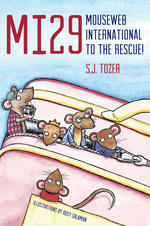
With all the action, adventure, twists and drama that every successful spy book contains, S.J. Tozer’s MI29 Mousweb International to the Rescue has the additional delight of having mice as the heroes of the stories! The ingenious way in which these lovable characters’ lives are incorporated within the human world gives this book a feeling of secrecy and excitement with the constant risk of detection around every corner.
A clear, recognizable ‘evil’ party is introduced early on in the book in the form of rats. In this case these stereotypical vermin help to keep the book moving and provide the perfect contrast to the innocent, altruistic worldwide network of secret agent mice. Using a family to represent the main characters in the story is extremely effective as the readers are able to empathize with the litter and their curious personalities, and understand the humour that comes with having siblings journey together through dangerous times.
The thoughts that this book provokes, especially in the younger readers, are impressive. You find yourself wondering ‘Am I ever really alone?’ and ‘Are humans the most advanced species?’ You find yourself questioning the likes of Charles Darwin on the fact that humans have evolved to become the ‘perfect’ species when this fictional book points your imagination in a different way.
The idea that animals have human characteristics has been around for years. Take the fairy tale ‘Goldilocks and the three bears’ for example. Here a picturesque bear family can be seen in a human cottage with human furniture, eating human food and doing human activities. In no way is this a bad thing but it is fascinating to see someone take that idea and turn it into something a whole lot bigger, so that when you are reading it, you feel as if you are one of the characters themselves. Being able to make people believe that they are, in this case, part of a secret society of rodents is extremely clever and takes an incredible amount of skill and imagination.
The message throughout the book is apparent as soon as you read the blurb. As Tozer had helped her daughter through a chronic illness of her own and the focus of MI29 (the mouse organization) was to help a young girl called Lily Watson who was terminally ill, it is evident that Tozer wants the reader to realize that those who are sick or vulnerable can be helped through their hardships. Having mice represent these helpers really stresses the fact that anyone can make a difference however small they are.
Kate Norton
50 Great Myths About Religions - by John Morreall & Tamara Sonn. Paperback. 256 pages. Price £16.99. ISBN: 978-0-470-67350-8. Published by Wiley-Blackwell.
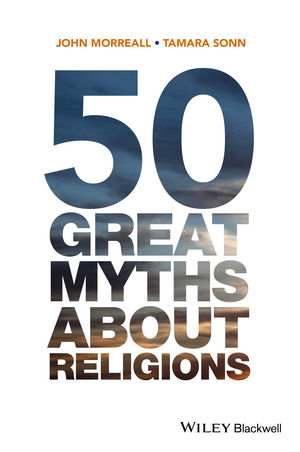
Having recently reviewed Wiley-Blackwell’s published title in this series dealing with 50 myths about Atheism, from the perspective of a secular humanist, I found the prospect of reviewing this latest title from a similar perspective quite irresistible.
The two books are totally dissimilar in presentation, the former having been written in a misleadingly light-hearted manner, a style that was reinforced by a liberal addition of “Jesus and Mo” cartoons. This current volume, however, is more academic, even though the authors are not reluctant to display flashes of humour, and makes far more interesting reading for one who has not previously read a great deal about comparative religions, and even less about the myths associated with them.
I ended my previous review with the suggestion that “people of faith” might be more offended than amused by the disrespect of the cartoons. Now I wonder just how such “believers” might react to this debunking of doctrine and dogma that they may have failed to recognise as mythology. Of course, just as belief relies on a suspension of doubt, it is possible that they might not want to risk having that belief shaken.
That would be a great pity. This debunking of myths, for the most part, is accompanied by very scholarly descriptions of how the myths originated and masterly digressions into their historical and philosophical backgrounds. Instead of beliefs being shaken, I suggest, a study of their origin would possibly reinforce the beliefs on which they are based.
There is
another respect in which a comparison of these two Wiley-Blackwell titles is misleading. One book is about Atheism, i.e. a general denial; the other book is not about Religion, i.e. a general belief, but about “religions”, and the 50 myths relate to a number of different religions as well as a few more general myths in the Introduction (Myths About Religions in General) where, in fact, the authors do move between religions and Religion.In their Introduction, the authors make a distinction between two types of myth, the one described as a false or unorthodox belief or opinion, especially in religion; the other being a traditional story that explains important aspects of life: thus the creationist (religious) view of the beginning of life as opposed to the evolutionist (scientific or Darwinian) view. The authors say, “We recognise and respect the scholarly notion of myths as stories conveying transcendental truths – truths immune from the rigors of scientific method. But for the purpose of this book, we use the skeptical view of myths: widely believed claims that are not well supported by historic or scientific evidence”. (p.4)
Following the Introduction, the authors have a section comprising eight “Myths About Religions in General”. I have to take issue with the authors here, because despite their having defined myths in two ways, presumably to give verisimilitude to the material that follows, I believe most of these eight “myths” may more exactly be termed “lore”. Thus, All Societies Have Religions, Religion is about the Spiritual, Religion is about Faith or Belief, Worship is an Essential Part of Religion . . . to quote but a few. Not that this is to decry what the authors have provided, but I think it could have been possible to broaden their earlier definitions of Myths to encompass these traditions.
They are on surer ground, however, when it comes to the specific religions and the myths associated with them. Thus: Judaism, Jews, and Jewish Scripture. As a secular Jew, I can certainly identify with several of them. Indeed, a personal experience from my childhood gave me nightmares for weeks subsequently and its impact is evidenced by the fact that I still recall it vividly 8 decades later! The Jews Killed Jesus (p.63). At age 7, my return home from school took me past a Roman Catholic church with a large crucifix adorning one wall. On one occasion I was accosted by a large (to me, at least!) youth who yelled: “You killed him!” Clearly – at least in this instance – a myth! I nevertheless ran home crying.
I am on less sure personal ground with the next two sections: Myths About Christianity, and Myths About Islam, but found the 19 myths described therein really fascinating. At random: (Christianity) The Four Gospels are Eyewitness Accounts of the Life of Jesus; Jesus Was a Christian; The Church Suppressed Science in the Middle Ages. (Islam) The Qur’an Condemns Judaism and Christianity; The Qur’an Encourages Violence; Muslims Reject Democracy.
The next two sections are equally absorbing, covering other Western and Eastern traditions, including Zoroastrians, Voodoo, Witches, Rastafarians, Hinduism, and Buddhism. But I found section 8 – Myths About Nonbelievers- somewhat out of place in this work; partly, I suppose, because it really belonged in the earlier book about Atheism, but also because – once again – I found their relevance to myths to be somewhat misplaced. But, putting that aside, the section made interesting reading.
The Bonus Myths of the final section were mainly well –known and very cleverly handled, with erudition and humour. The Apocalypse is the End of the World; Cherubs are Cute, Childlike Angels; There was a Female Pope Named Joan; and a whole series of fabled statements attributed to the Bible, e.g. Cleanliness is next to Godliness; Hate the Sin, Love the Sinner; Money is the root of all evil; This too shall pass . . . and so on.
Well worth reading whatever your faith or belief.
Sep Meyer
Introduction to the Psychology of Ageing for Non-Specialists - by Ian Stuart-Hamilton. Paperback. 240 pages. Price £16.99. ISBN: 978-1-84905-363-1. Published by Jessica Kingsley Publishers.
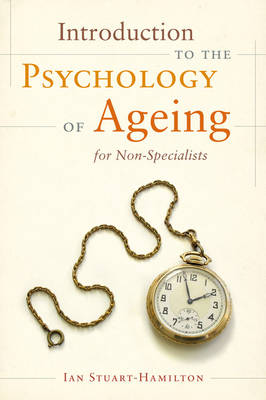
Professor Ian Stuart-Hamilton is almost certainly the most perfectly equipped academic to have written this book. Professor of Developmental Psychology at the University of Glamorgan, Wales, his many published books includes The Psychology of Ageing, which ran to five editions, was translated into 16 languages, and was awarded a British Medical Association Book of the Year award in the Geriatric Medicine section in 2008. This work comprised an extensive view of the psychological processes of ageing and was addressed primarily to an audience of professionals in the area of gerontology as well as students and academics. The 5th Edition was published in 2012.
Now Professor Stuart-Hamilton has written a text that basically covers similar ground, but purports to be addressed to "Non-Specialists". Since his credentials are unquestionable, the major question facing a reviewer is: how far has he succeeded in making his book accessible to a non-specialist audience without, in the process, losing anything of value in the original, major work?
Given that brief, allow me immediately to affirm my competence as a reviewer of the book. In the first place, I am well past the biological age at which the subject matter first became a personal concern. Secondly, at least twenty years ago I was engaged (semi-professionally) as a facilitator of workshops devoted to the related issues of Ageing and Death. I believe that both these elements uniquely qualify me to offer a critique of the subject and, specifically, of the author’s treatment of it.
I believe, too, that this may prompt me to introduce more of a personal note than I would normally regard as acceptable beneath my editorial headgear, which I will conveniently discard in this instance in the hope that my evaluation of what Ian Stuart-Hamilton has sought to achieve in this “Introduction” will be of as much interest to others, as it is to myself.
Furthermore there is a resonance between this exculpation and the author’s own description of his personal circumstances in the book’s preface, with the delay in its publication resulting partially from having to deal with his mother’s dementia. The experience of my own mother’s descent into senile dementia was partly responsible for my personal immersion into the study of ageing, and my concern that that experience might prove genetic, worried me to the extent that, at one point, I obliged my closest friend to inform me should he spot any warning signs, such as unusual loss of memory, in my behaviour.
It is now, however, more than twenty years since I was actively involved in this area of study and, significantly, even longer since I really updated myself on developments in the field of psycho-gerontology. What is most astonishing, and borne out by Stuart-Hamilton’s comments, is the rate of growth of knowledge about ageing in the intervening period; the increase in life expectancy (the chronological age); the causes and consequences of change in biological ageing.
The first chapter, Some Basic Information About Ageing, is concerned with various aspects of life expectancy, how it has changed over the years, the differences in the ways in which it is measured, and the problems and conditions that have to be faced as a consequence of the ageing population.
Chapter Two is entitled Intelligence. It asks the question What are the causes of intellectual change? Then considers the patterns of intellectual change and the ways in which it is measured.
Chapter Three deals with memory: short term memory, long term memory, how memory responds to ageing dependent upon the complexity of the task facing the older person.
Chapter Four. Language. Stuart-Hamilton’s attempts in this chapter to identify affected language skills with the age-related decline of sight and hearing, I found somewhat thin. In fairness he does state (p.87) “It should . . . be emphasised that, as with intelligence and memory, the changes we will examine are relative and not, repeat not, absolute”. And in the Summary (p.107) “The study of language changes in older people is currently fragmented”.
In Chapter Five he turns his attention on “the psychological factors that are largely concerned with how older people interact with the world around them, through their personality and lifestyles”. (p.109) This is by far the longest chapter in the book and, possibly, this is because it most closely relates to the subject matter indicated by the title. I found it of most interest although, once again, I have to confess to some small concern with the degree of generalisation that is included. For example, several of the instances of psychological responses to lifestyle situations where the author has related these to ageing might be equally appropriate at any age
Similarly, in the final chapter on Mental Health in Later Life he discusses conditions that are not specifically age-related concerns. Indeed, the author says (p.182) “Dementia is not unique to old age”. And “in many instances evidence points to these [problems] not being appreciably worse in themselves than those faced by younger patients with the same illnesses. Of course, contracting a mental illness in later life does not absolve the patient from becoming ill with common age-related physical complaints such as arthritis or hearing impairment, and of course it may be anticipated that these will exacerbate the problem.”
So, despite the few minor quibbles, that undoubtedly reflect the basic requirement of making a complex specialist subject simple. comprehensible and above all interesting to a non-specialist audience, did I find the result successful? Well, the answer must be a resounding affirmation. Just "for a giggle" I located on my bookshelves, where it has lain mouldering for 25 years, the book* that was my main text in the 1980s, when I was facilitating workshops on ageing for the London Co-Counselling Community and the Group Relations Training Association, and found it "dry as dust". Ian Stuart-Hamilton, where were you when I needed you?
At those workshops I invariably placed three notices on the walls: one read "Ageing is a Biological Condition"; the second stated "Growing Old is a State of Mind", and the last suggested "Death is an Adventure". Well Professor Ian Stuart-Hamilton nowhere in his book lends credence to the last of these comments, but I am happy to discover, after reading it, that 25 years on I see no reason to change the first two conclusions.
* The Psychology of Human Ageing by D.B Bromley (Penguin Books 1975).
Joe Sinclair
Sleep Better With Natural Therapies - by Peter Smith. Paperback. 272 pages. Price £13.99. ISBN: 978-1-84819-182-2. Published by Singing Dragon.

SLEEPLESS IN SU
BURBIAI didn’t sleep well last night.
I woke up three or four times, at roughly two-hourly intervals, and then went immediately back to sleep.
This is not an unusual condition. It is a mild (non-obstructive) example of what is known as sleep apnoea, or interrupted sleeping. It is a condition with which I am quite familiar. It is also covered in Peter Smith’s book.
Sleep apnoea occurs more frequently with old age.
This is another condition with which I am, alas, only too familiar. It is, however, a condition that is not covered, except in passing, in Sleep Better With Natural Therapies.
And, thinking about it, I am possibly the wrong person to review this book.
I have always believed that sleep and problems associated with sleep – as with so many other health concerns – are best treated by removing the mental worry associated with them. Frequently – or such has been my experience – the act of worrying about a condition can produce greater problems than the condition itself. It must follow, therefore, that finding ways and means to remove, inhibit, or at least reduce the worry must be an effective first step in its treatment.
This type of therapy, typical of Neuro –Linguistic Programming (NLP) and Cognitive Behaviour Therapy (CBT) are not only features of Peter Smith’s approach in his Guide, but also formed the basis of two of my own published titles: An ABC of NLP and Peace of Mind is a Piece of Cake. Accordingly Peter Smith, with me as a reader, is effectively preaching to the converted.
On the other hand, maybe there is a case for one of the "converted" to act as a mirror to reflect an alternative approach - or a wall for new ideas to bounce off. Carl Rogers said "a mirror should reflect a bit before casting images." Well, I've reflected at length and actually have nothing but praise for the way in which the author has arranged and presented this very comprehensive study of a condition that affects everyone at some time to a greater or lesser extent. Peter Smith has not only addressed all the usual causes of sleep disorder: the difficulty in falling asleep; the difficulty in staying asleep; the quality of the sleep itself; and the problems associated with waking from sleep, but he has also considered the conventional medical causes and orthodox treatments, before embarking upon his own "unique" Treatment Programme.
This is a five-week "step-by-step" treatment programme that involves increasing melatonin, which is a sleep-inducing hormone; dieting to eliminate sleep inhibitors; coming off drugs and pills; practising relaxation techniques. These five steps are followed by a sixth step "Consolidating and perpetuating your gains".
The final section of the book is concerned with "restoring healthy sleep cycles" and includes a section offering measures for dealing with jet lag, after which various resources are proposed, dietary supplements and recommended meditations.
All in all a masterly exposition and it is hard to think of anything more that might be added, particularly since the foregoing comments have only touched the surface of all that the author has included. I got a lot from the book, despite my previous exposure to many of the techniques described therein, and I would imagine that the majority of readers will find it an invaluable aid in dealing with sleeping problems without recourse to prescription drugs.
In NLP there is a concept known as "Anchoring". This is a technique for making a past "state of excellence" available to deal with a present situation. The way in which this is achieved is inappropriate for description in this review. Suffice it to say, that it occurs to me that if I adopt some of Peter Smith's suggestions in order to deal with my occasional attacks of mild sleep apneoa, and then use his book as an "anchor", I could keep it at my bedside and the next time I suffer a sudden recall from sleep to wakefulness, I might simply reach for the book and - in theory - promptly fall asleep again.
Hmmm. I might just try that!
An ABC of NLP - -ASPEN, 1992
Peace of Mind is a Piece of Cake - Crown House, 1998
Joe Sinclair
Starving the Stress Gremlin - by Kate Collins-Donnelly. Paperback. 135 pages. Price £12.99. ISBN: 978-1-84905-340-2. Published by Jessica Kingsley Publishers.
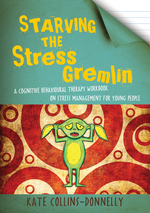
As ' Road to Damascus' experiences go, my conversion from cynical skeptic to CBT enthusiast does not parallel what happened to St Paul. Mine has been a somewhat tortuous journey that has spanned several years of training (delivering and receiving), therapeutic work (delivering and receiving), and reading (receiving, I suppose, though I have created one or two self-help tracts). As a therapist who works primarily with children, teenagers and parents I very much welcome a further addition to the canon of 'DIY' workbooks with a cognitive-behavioural basis.
Starving the Stress Gremlin is clearly a workbook - it says so on the cover- and is constructed around a series of exercises that the young person is required to complete. (CBT therapists are always at pains to make it clear that CBT is a journey that is embarked on collaboratively; the recipient is expected to play a full and active part in the process of learning about the source of their problem, and how to manage it.) The book is designed to be teenager-friendly : it uses cartoons and diagrams effectively and contains a number of quizzes and questions which are likely to appeal. There are cartoon images scattered throughout, mainly that of the Stress Gremlin (itself a very useful way to help the young person externalise their anxiety) though I did feel that the text could have been enlivened with a few more visual images.
But this is a minor carp - the overall presentation of the book is excellent. The reader is taken through a process which explains the origins of stress in human beings; that it is a survival mechanism that we all possess. However, distorted thinking may cause heightened stress responses to occur in inappropriate situations. The author gives examples of contrasting responses to potentially stressful situations - an exam, for example - using fictionalised (I assume) teenagers which helps make the book relevant to the intended audience. There are lots of examples of stress-inducing thinking and these are helpfully categorised and structured which reinforces the reality that a young person is not alone in thinking this way - it is a common part of human experience.
The latter part of the book contains suggestions for relaxation and visualisation activities; I did find this section a little thin. It would have been useful to include a more comprehensive visualisation rather than confine it to a short paragraph. The reader is encouraged to develop their own structured approach to managing stress with plenty of suggestions from the author, again emphasising the self-help nature of the book. The final chapter is a summing - up, including a quiz about all that the reader has learned and an invitation to 'spread the word' and it clearly emphasises the structured and logical approach that CBT is all about.
Starving the Stress Gremlin is a good introduction to CBT for young people and parents; however there are some limitations. I would have liked a section on tracking thoughts back to core beliefs and perhaps suggestions for further reading. But please don't let this put you off. It has taken me five years to become a CBT disciple; remember the old saying - that a journey starts with a single step. This book could be that step.
Mark Edwards
Coaching and Mentoring for Business - by Grace McCarthy. Paperback. 232 pages. £28.99. ISBN 9780857023360. Published by Sage Publishing.
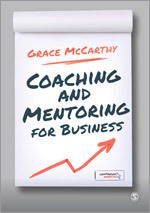
This is a very thorough book! The author is clearly widely read and provides numerous references to the work of others on coaching and related topics. She also includes in each chapter a number of URLs for access to resources, although the Companion Website was a bit disappointing as much of the content is for lecturers only; for students it contains only some quizzes about the book content without any indication of correct answers, and some self-assessment sheets.
The book begins with a comprehensive survey of theories and models about coaching and mentoring, and the skills required, and goes on to relate coaching and mentoring to individual change and to organisational change, to leadership, strategy and innovation. There are also chapters about cross-cultural and virtual coaching and mentoring, and about ethical issues.
I very much enjoyed reading about so many different aspects, and especially the various models that were presented and which included summaries of a wide range of approaches. For example, in the chapter on strategy we find an explanation of what strategy is, comments about being a safe sounding board, blind spots, biases and framing, scenario planning, listening to different voices, appreciative enquiry, prevailing beliefs and stories, stakeholder analysis and systems approach, strategy development, identifying strengths, awareness of biases, imperfect information, decision-making, commitment, strategy communication and goal setting, followed by a section with a vignette about coaching and mentoring SMEs and family businesses, and a list of 10 different strategy tools that coach mentors might use with clients. Each of the chapters is equally rich.
However, there were times when I felt that there was just too much information. I could see that this would be a very useful book for those who want to obtain a wide-ranging overview of what coaching and mentoring involve. However, I had the sense that for a coach or mentor to develop their competence, the book would need to be used as a text within a comprehensive training programme where a lecturer would be providing more information to supplement what in many cases are fairly brief summaries. This is of course the background to the book - the author is an Associate Dean in a University Faculty of Business.
Somewhat surprisingly in view of the author’s background, I also missed any sense of critique – many ideas and much research was quoted but there was little about how well conducted or valid the findings were.
On the other hand, I feel that the author has unnecessarily limited the profile of her readers. By including ‘Business’ in the title, she potentially excludes those interested in coaching and mentoring in organisations such as government bodies, educational institutions, non-profit organisations and so on, who I believe will find this book just as useful to them.
So, in summary, whatever kind of organisation you operate within, this book will give you a very thorough overview of a wide range of aspects related to coaching and mentoring – although you may then want to check out for yourself some of the original sources of the information, and you may want to treat the book as a useful text within a training programme if you intend to develop your own skills.
Julie Hay
Coaching and Mentoring - Theory and Practice, 2nd Edition - by Bob Garvey, Paul Stokes & David Megginson. Paperback. 297 pages. £27.99. ISBN: 9781446272336. Published by Sage Publishing.
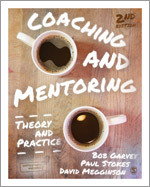
This is a book for those who want to think deeply about coaching and mentoring; it goes well beyond the ‘how-to-do-it’ of many texts and challenges us to pay attention to the wider implications of what we are doing. The authors draw on many sources, always with a critical approach that invites us to think about how what has been written has been influenced by the perspectives and discourses of the time and culture.
They provide an extensive list of references, and many examples and case studies from a range of sectors and professions. There is also a Companion Website, although at the time of writing this review this required registration to access lecturer power points and said that the Sage journals online readings for students are not yet available.
Early on, the authors conclude that there is no one definition for coaching and/or mentoring, nor is there ever likely to be. Instead, they suggest that we consider the setting, the social practices and whose agenda is being served. They go on to outline a framework of research approaches, showing how these have been impacted by different philosophical positions. They conclude that much mentoring research has been written by academics for academics, whereas many coaching articles are aimed more at practitioners and purchasers.
In the following chapters, they invite us to consider in turn what is known about creating a coaching and mentoring culture, and how to design and evaluate schemes. Then, still within their ‘Introduction’ section of the book, they provide a comprehensive overview of models and perspectives, commenting that too much focus on techniques is reductionist. Instead, they refer to sports coaching, life coaching, executive coaching, team coaching and brief coaching before going on to provide overviews of approaches such as cognitive behavioural, gestalt , narrative-based and positive psychology coaching. In the same chapter, they mention executive mentoring, diversity, mentoring, mentoring in education, and voluntary sector mentoring, followed by modes including traditional dyadic mentoring, peer mentoring, co-mentoring, e-mentoring and reverse mentoring.
The next chapter is a relatively short one about conversational learning, before in Part Two the authors provide more extensive chapters that cover issues of power, multiple relationships, E-development, and their challenge to the assumptions made around the need for automatic goal setting within coaching and mentoring relationships.
Part Three is about contemporary issues, for which they include supervision, with a challenge to the current emphasis on this being conducted on a formal and one-to-one basis, diversity, which is another short chapter consisting largely of a case study, and professionalization where they comment on research into competencies, the pros and cons of professional standards and accreditation, and the influence of the European Union.
The final chapters are a perspective on coaching and mentoring in the United States (by a 4th author) and their own summary of the themes they have identified and their suggestions about what is needed in the future. They comment that “We place this into the public domain, not as a finished and tested theory but as a framework for debate and discussion. As we stated in the introduction of the book, we want this to be both a challenge and a basis for support. We value critical thinking and as such offer our thoughts up to criticism in the spirit of learning and the generation of new thinking.” (p. 252). This quotation reflects well the way this book is written - with a constructive style of challenge that prompts us to go well beyond any assumptions that we might already know the best way to do coaching and mentoring.
Julie Hay
Happy Mind Happy Life - How to get happy and stay that way the rest of your life - by Don Schenk. Paperback. 180 pages. ISBN-13: 978-1937201074. Price £9.66 to include free UK delivery. Published by Ideapage.

Happy Mind Happy Life is a useful book aimed at changing the ways in which you think about yourself and the world.
Although not written by a mental health professional it's as well researched as anything you're likely to read from a journalist specializing in wellness.
It is an ambitious book that sets out a number of useful methods to help you to change your mindset. These include visualization and the editing of internal dialogue.
The book encourages the reader to keep upbeat company, and to use the techniques contained to maintain their own positivity in the face of adversity.
The author was for many years a business owner, and the book summarizes his own search for happiness, the ways he turned a failing business round, overcame health problems and much more.
Central to the book's theory is what psychologists refer to as Psychosynthesis, the mastery of that Greek Chorus of conversations that occur in our minds and can undermine success and happiness.
If I have a quibble with the book it's simply that in places it seemed to contain too many examples of how people make themselves suffer due to inappropriate conditioning. I was just too eager to dig in and get to the next helpful paragraph!
Although this is a self-help book for those seeking more fulfillment it also has some sound tips for helping others achieve happiness, including how to write in more uplifting ways.
If you read the book and apply the techniques methodically this book can help you.
Stephen Bray
Warriors and Worriers - The Survival of the Sexes - by Joyce F. Benenson with Henry Markovits. Hardback. 276 pages. Price £16.99. ISBN 978-0-19-997223-4. Published by Oxford University Press.

Professor Henry Higgins unforgettably in My Fair Lady bewailed "Why can't a woman be more like a man?". Thereafter, for several decades, the feminist movement - with Betty Frieden's The Feminine Mystique 1963 and Germaine Greer's The Female Eunuch 1970 as two major influences - seemed determined to prove that women should be more like women. Higgins (and, indeed, GBS) and the feminists had their separate agendas. The agenda of Joyce Benenson is different again. In the preface she tells us that she "wrote this book to provide a development psychologist's perspective on sex differences" She adds "Over the past 30 years I have come to believe that boys and girls differ in some of their basic interests and accordingly behave in different ways":
Benenson's thesis seems to be that men, i.e. warriors are genetically adapted to warfare and aggression as their role in the age-old nature versus nurture debate. Women, however, are on the nurture path and are natural worriers. Survival for us means placing the moral and physical welfare of self and family above all else. Her research also suggests that there is less collaboration between women than between men. Her view, based on her work with children, is that boys typically interact in groups while girls tend to focus on one-on-one relationships. Her study of the behaviour of chimpanzees suggests, interestingly, that these animals organise their relationships in nearly identical ways.
Benenson declares that women typically do not compete directly with men due to fear of men’s greater size, aggressiveness, and capacity for physical violence. This is more pronounced in primitive societies. By contrast, in advanced societies female power strategies have become politically effective, partly because women can treat men as they treat other women. Men lose the advantage of physical strength because advanced societies place severe sanctions on violence against women. Advanced societies also prohibit organisations that exclude women. All this suggests that in advanced societies men have become more like women. Zero tolerance policies have reduced masculine aggression, while feminine egalitarianism and conformity is extolled.
[So, sucks to you, 'Enery 'Iggins!]
The book is a fascinating study on how boys and men address certain issues and cope with certain situations while girls and women have totally different responses, but although Benenson does provide evidence on how there has been a narrowing of the gap between them, there remains a host of questions about why so many differences still exist.
Penelope Waite
BIODATA OF REVIEWERS
![]()
Terry Goodwin was a senior marketing executive at Finexport Ltd in London and Bangkok until his retirement in 1992, since when he has been in private practice as a marketing consultant.
Joe Sinclair is Managing Editor of New Nurturing Potential as well as the presenter of Potential Unleashed. He is the author of twelve books including An ABC of NLP and co-author of Peace of Mind is a Piece of Cake.

Sep Meyer is a graduate of the London School of Economics and, since his retirement from a commercial life, has occupied himself with writing poetry and drama, as well as articles in the area of sociology, politics and current affairs.
Kate Norton is a 12-year old student at Bromley High School, where Nurturing Potential's Editor for the Arts, Caroline Jenner, teaches English and Drama. Given this JKP title for review, Caroline conceived of the idea of offering it as a special project to Kate, knowing that she loves reading. Kate's ambition is to be a writer. We are delighted with the review, which displays her promise, and hope that both publisher and author will be equally pleased.

Mark Edwards lives in Exeter and works as a Primary Mental Health Worker in South Devon. He has a developing interest in working systemically and the focus of his work is with children and families. He runs a successful course for parents on Managing Challenging Behaviour

ProfessorJulie Hay
FCIPD, MCMI, is
a consultant, coach, supervisor,
author
of numerous books, packs, audiotapes and
articles, internationally accredited as Teaching & Supervising Transactional
Analyst (Organisational and Educational) and internationally licensed NLP
Trainer.